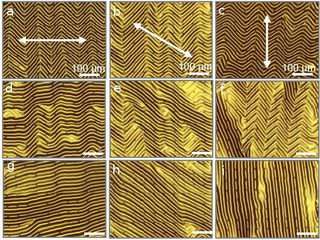June 13, 2007 feature
Stretchable Silicon May Inspire a New Wave of Electronics

Scientists have created a form of nanoscale silicon that is stretchable. The new material may help pave the way for a class of stretchable electronic devices, such as “smart” surgical gloves and personal health monitors, that are not possible to create using current technology and materials.
“Electronics that are bendable have many potential applications, but reversible stretchability is a different and much more technically challenging characteristic,” said corresponding researcher John Rogers, a materials scientist at the University of Illinois at Urbana-Champaign (UIUC), to PhysOrg.com.
Rogers and colleagues from UIUC and the University of Arizona created an ultra-thin silicon membrane from a silicon wafer and merged the membrane with a slab of a silicon-based polymer. The overall process involved several steps but, in short, the group first “pre-strained” the polymer slab, pulling it taut, before they topped it with the prepared silicon. When they released the strain the silicon buckled, resulting in a series of raised wavy ridges forming a herringbone-like pattern. The finished composite membrane is about 100 nanometers thick and can stretch biaxially – that is, in both the vertical and horizontal directions.
The group performed several stretching tests on the membrane by pulling it from various directions. Stretching it horizontally caused the herringbone pattern to straighten out. Stretching along the diagonal produced similar changes until, at full stretch, straight diagonal ridges formed. And stretching along the vertical direction – perpendicular to the waves – produced straight vertical ridges. In each case, the membrane recovered its original pattern when the strain was released.
These temporary stretching-induced structural changes occur primarily at the membrane’s central region. In its pre-stretched state, the herringbone pattern is far less pronounced at the membrane’s edges. There, the waves give way to fairly straight ridges, and thus the edge of the membrane does not have the elasticity of the central region. However, Rogers and his colleagues say that this could be an asset in certain applications. For example, a medical imaging system that is stretchable – able to conform to the contours of the human body to achieve more detailed images – might perform better if regions directly above the device’s photodetectors (which collect light reflecting from the object being imaged) are kept flat.
In their paper describing the work, in the May 8 online edition of Nano Letters, Rogers and his colleagues also discuss theoretical predictions of the membrane's behavior. They note that these predictions match their experimental observations, specifically in terms of the shape and dimensions of the waves. This theoretical component of the research, performed by UIUC scientist Young Huang, a co-author of the paper, is a significant result of their work.
Rogers and his group have previously produced structures with similar qualities: stretchy, ridged nanoribbons made of silicon and gallium arsenide. Other research groups have made circuit components consisting of stretchable metal wires connecting rigid islands. However, the nanoribbons are only stretchable lengthwise and the wire-island structures provide circuit-level stretchability rather than stretchable devices.
Citation: Won Mook Choi, Jizhou Song, Dahl-Young Khang, Hanqing Jiang, Yonggang Y. Huang, and John A. Rogers. “Biaxially Stretchable ‘Wavy’ Silicon Nanomembranes” Nano Lett., ASAP Article 10.1021/nl0706244 S1530-6984(07)00624-8
Copyright 2007 PhysOrg.com.
All rights reserved. This material may not be published, broadcast, rewritten or redistributed in whole or part without the express written permission of PhysOrg.com.



















